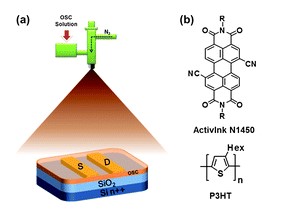Spray-printed organic field-effect transistors and complementary inverters
- 저자
- Dongyoon Khim, Kang-Jun Baeg, Byung-Kwan Yu, Seok-Ju Kang, Minji Kang, Zhihua Chen, Antonio Facchetti, Dong-Yu Kim and Yong-Young Noh.
- 저널명
- Journal of Materials Chemistry C, 1, 1500-1506 (2013)
- 년도
- 2013
- Link
- http://dx.doi.org/10.1039/C2TC00085G 230회 연결
[Abstract]
We report the fabrication of high-performance organic field-effect transistors (OFETs) and complementary inverters using spray-printed films of n-type small-molecule semiconductors and p-type conjugated polymers. Highly crystalline organic semiconductor films could be obtained by controlling the droplet size, nozzle-to-substrate distance, and solvent drying speed during the printing process. After the optimisation of the spray-printing process, the performances of the spray-printed OFETs were comparable to those of spin-coated and inkjet-printed OFETs. In addition to excellent device-to-device uniformity, the spray-printed n- and p-channel OFETs also exhibited high field-effect mobilities, which were ∼0.3 (ActivInk™ N1450, Polyera), ∼0.01 (regioregular-poly(3-hexylthiophene) (rr-P3HT)), and ∼0.25 cm2 V−1 s−1 (ActivInk™ P2100, Polyera). Organic complementary inverters were fabricated by spray printing and shadow-mask patterning while using ActivInk™ N1450 and P2100 as the n- and p-type semiconductors, respectively. The complementary inverters exhibited a large voltage gain (∼17) and a low power consumption (∼0.02 mW) at VDD = 60 V.
